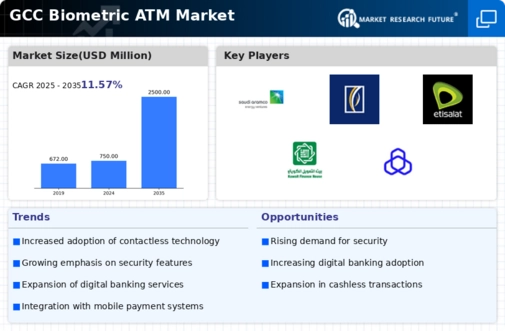Technological Advancements
The biometric atm market is significantly influenced by rapid technological advancements in biometric systems. Innovations in artificial intelligence and machine learning are enhancing the accuracy and efficiency of biometric recognition systems. In the GCC, the integration of advanced biometric technologies into ATMs is becoming more prevalent, with banks seeking to leverage these advancements to improve service delivery. For instance, the implementation of multi-modal biometric systems, which combine various recognition methods, is gaining traction. This not only increases security but also enhances user convenience. The market for biometric authentication in the GCC is expected to reach $1 billion by 2026, reflecting the growing reliance on cutting-edge technology in the banking sector. As these technologies evolve, they are likely to play a pivotal role in shaping the future of the biometric atm market.
Increasing Security Concerns
The biometric atm market is experiencing a surge in demand due to escalating security concerns among consumers and financial institutions. With the rise in cybercrime and identity theft, traditional ATM security measures are proving inadequate. Biometric technologies, such as fingerprint and facial recognition, offer enhanced security features that are difficult to replicate or bypass. In the GCC region, banks are increasingly investing in biometric solutions to protect customer data and transactions. According to recent data, the biometric authentication market is projected to grow at a CAGR of 20% from 2025 to 2030, indicating a strong shift towards more secure banking solutions. This trend is likely to drive the adoption of biometric ATMs, as they provide a robust defense against fraud and unauthorized access, thereby fostering consumer trust in financial services.
Consumer Demand for Convenience
The biometric atm market is increasingly driven by consumer demand for convenience and seamless banking experiences. As customers seek faster and more efficient ways to access their funds, biometric ATMs offer a solution that eliminates the need for PINs and cards. In the GCC, where a tech-savvy population is prevalent, the appeal of quick and hassle-free transactions is particularly strong. Biometric authentication not only speeds up the transaction process but also enhances user experience by providing a more personalized service. Recent surveys indicate that over 70% of consumers in the region express a preference for biometric solutions over traditional methods. This growing consumer inclination is likely to propel the adoption of biometric ATMs, as banks strive to meet the evolving expectations of their customers and remain competitive in the market.
Competitive Pressure Among Financial Institutions
The biometric atm market is influenced by competitive pressure among financial institutions striving to differentiate themselves in a crowded marketplace. As banks in the GCC seek to enhance their service offerings, the integration of biometric technologies into ATMs is becoming a strategic priority. Institutions that adopt biometric solutions can position themselves as leaders in security and innovation, attracting a larger customer base. The competition is further intensified by the entry of fintech companies that are leveraging biometric technologies to offer innovative banking solutions. This competitive landscape is likely to drive investment in biometric ATMs, as traditional banks aim to keep pace with emerging players. As a result, the biometric atm market is expected to witness robust growth, fueled by the need for financial institutions to innovate and provide superior customer experiences.
Regulatory Frameworks Supporting Biometric Solutions
The biometric atm market is benefiting from supportive regulatory frameworks that encourage the adoption of biometric technologies in financial services. Governments in the GCC are recognizing the importance of enhancing security measures in banking and are implementing regulations that promote the use of biometric authentication. For example, the Central Bank of the UAE has issued guidelines that advocate for the integration of biometric systems in ATMs to bolster security and customer verification processes. This regulatory support is likely to accelerate the deployment of biometric ATMs across the region. Furthermore, compliance with these regulations can enhance the reputation of financial institutions, making them more attractive to customers. As a result, the biometric atm market is poised for growth, driven by a favorable regulatory environment that encourages innovation and investment in secure banking solutions.

















Leave a Comment